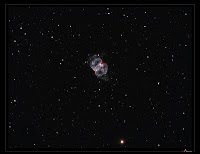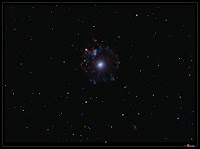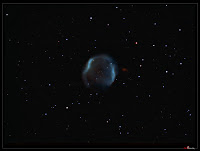COPYRIGHT, PLEASE NOTE
All the material on this website is copyrighted to J-P Metsavainio, if not otherwise stated. Any content on this website may not be reproduced without the author’s permission.
Have a visit in my portfolio
PORTFOLIO:https://astroanarchy.zenfolio.com/
Friday, February 4, 2011
A Planetary Nebula poster
Note! There is now a Gray circle, size of the full Moon, as a scale.
I made this poster to show and understand relative sizes of the nebulae. All Planetary Nebulae in this image are in same scale. Each individual image covers an area of 20' horizontally. (~0,3 degrees) and
they are in "natural" colors, mixed from the narrowband channels. By a following method:
Natural color composition from the emission of ionized elements, R=80%Hydrogen+20%Sulfur, G=100%Oxygen and B=85%Oxygen+15%Hydrogen to compensate otherwise missing H-beta emission. This composition is very close to a visual spectrum.
I have made a similar poster out of supernova remnants as well, you can see it from here:http://astroanarchy.blogspot.com/2011/02/supernova-remnant-poster.html
I have made a similar poster out of supernova remnants as well, you can see it from here:http://astroanarchy.blogspot.com/2011/02/supernova-remnant-poster.html
All images, expect NGC 6302 (Bug Nebula), are shot from my urban observatory in very centrum of city Oulu. NGC 6302 was shot with a remote telescope, 16" RCOS, from Australia.
All of the images are Planetary Nebulae.
Planetary nebulae are shells of gas, shed by stars late in their life cycles after using up all of their nuclear fuel. The gas is illuminated and ionized by its extremely hot central star, a core left from the original star.
Our own star, the Sun, is expected to undergo the same process in a couple of billion years.
Images, from top Left to a bottom Right
Click thumbnails for large images, technical data behind links
Click thumbnails for large images, technical data behind links
M27, the "Dumbbell Nebula":
M76, the "Little Dumbbell Nebula":
http://astroanarchy.blogspot.com/2010/11/m-76-little-dumbbell-nebula.html

PK 164+31.1, Jones-Emberson 1:

PK 164+31.1, Jones-Emberson 1:
M57, the "Ring Nebula":
http://astroanarchy.blogspot.com/2010/10/m57-ring-nebula-project-finalized.html

Sh2-188:
http://astroanarchy.blogspot.com/2010/11/sh2-188-project-finalized.html
NGC 6543, the "Cat's Eye Nebula":
http://astroanarchy.blogspot.com/2010/10/m57-ring-nebula-project-finalized.html

Sh2-188:
http://astroanarchy.blogspot.com/2010/11/sh2-188-project-finalized.html
NGC 6543, the "Cat's Eye Nebula":
http://astroanarchy.blogspot.com/2011/01/cats-eye-nebula-reprocessed.html

Sh2-274, the "Medusa Nebula":
http://astroanarchy.blogspot.com/2011/02/medusa-nebula-sh2-271-project-finalized.html
Jones 1:
http://astroanarchy.blogspot.com/2010/11/jones-1-extreme-dim-planetary-nebula.html

NGC 6302, the "Bug Nebula":

Sh2-274, the "Medusa Nebula":
http://astroanarchy.blogspot.com/2011/02/medusa-nebula-sh2-271-project-finalized.html
Jones 1:
http://astroanarchy.blogspot.com/2010/11/jones-1-extreme-dim-planetary-nebula.html

NGC 6302, the "Bug Nebula":
Thursday, February 3, 2011
M27, the "Dumbbell Nebula", as a Stereo Pair 3D
3D-experiment with the M27
Parallel vision 3D
NOTE! This is a personal vision about forms and shapes, based on some known facts and an artistic impression.
Labels:
stereo images
M27, the "Dumbbell Nebula", as an anaglyph Red/Cyan 3D
You'll need Red/Cyan Eyeglasses to be able to see this image right.
Note, if you have a Red and Blue filters, you can use them! Red goes to Left eye.
A closeup
NOTE! This is a personal vision about forms and shapes, based on some known facts and an artistic impression.
Labels:
anaglyph images and movies
Wednesday, February 2, 2011
M27, the "Dumbbell Nebula", reprocessed
Since my processing technique gets better and weather doesn't give any support, I have reprocessed some older images. There is now star colors added and other processing is tweaked too.
Messier 27, the "Dumbbell Nebula"
Ra 19h 59m 36.340s Dec +22° 43′ 16.09″
Be sure to click to an image to see it in large size!
Natural color composition from the emission of ionized elements, R=80%Hydrogen+20%Sulfur, G=100%Oxygen and B=85%Oxygen+15%Hydrogen to compensate otherwise missing H-beta emission. This composition is very close to a visual spectrum.
Natural color composition from the emission of ionized elements, R=80%Hydrogen+20%Sulfur, G=100%Oxygen and B=85%Oxygen+15%Hydrogen to compensate otherwise missing H-beta emission. This composition is very close to a visual spectrum.
The Dumbbell Nebula (also known as a Messier 27, M 27, or NGC 6853) is a planetary nebula in the constellation Vulpecula, at a distance of about 1360 light years. It has a large angular diameter as a planetary nebula, about 8 x 5,6 arc minutes. (Rarely imaged outer halo is not included, it can be seen in my image. With an outer shell, the diameter is over 15'' (more than a size of the half a Moon))
Planetary nebulae are shells of gas shed by stars late in their life cycles after using up all of their nuclear fuel. The star then ejects a gaseous shell, which is illuminated by its extremely hot central star, a core left from the original star. n this image, the central star is clearly visible at very center of the nebula. M27's central star has a magnitude of 13.5 and is an extremely hot blueish dwarf with a temperature of about 85,000 K.
Our own star, the Sun, is expected to undergo the same process in a couple of billion years.
Be sure to click to an image to see it in large size!
Image is in HST-palette, (HST=Hubble Space Telescope)
Image is in HST-palette, (HST=Hubble Space Telescope)
from the emission of ionized elements, R=Sulfur, G=Hydrogen and B=Oxygen.
Star colors are mixed from the NB channels, Red=H-a, G=O-III and B= 85%O-III + 15%H-a.
A closeup
no other processing, than calibration, stacking and nonlinear stretching.
In the final image, light deconvolution with a CCDSharp software was added, 30 iterations.
(Value 3 in CCDSharp)
Image is shot with a QHY9, Baader narrowband filter set and the Meade lx200 GPS 12" telescope..
Original versions from November 2009, with technical details:
Subscribe to:
Posts (Atom)

















